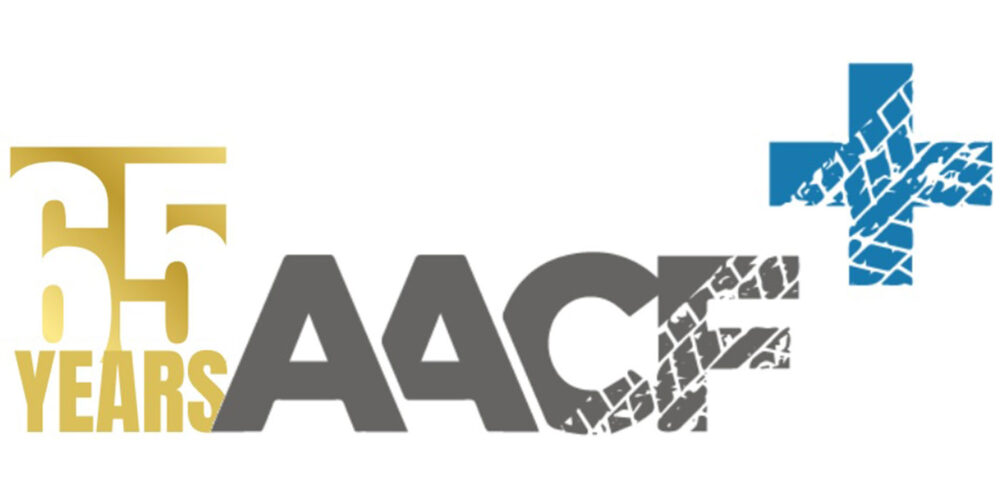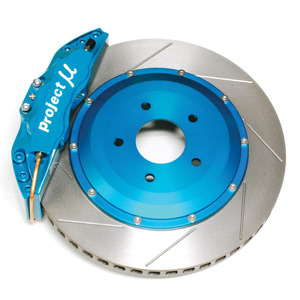 Brake jobs are a good source of parts and labor income for import repair shops. When brakes wear out, most motorists just want you to fix the problem and restore their brakes to like-new condition with OE-equivalent replacement parts. But in some situations, there may be an opportunity to sell your customer on the benefits of upgrading certain brake components. We’re talking upgrades like:
Brake jobs are a good source of parts and labor income for import repair shops. When brakes wear out, most motorists just want you to fix the problem and restore their brakes to like-new condition with OE-equivalent replacement parts. But in some situations, there may be an opportunity to sell your customer on the benefits of upgrading certain brake components. We’re talking upgrades like:
• Installing premium-grade pads that can handle higher brake temperatures without fading or wearing excessively;
• Replacing the stock rotors with aftermarket performance rotors that are slotted and/or drilled or dimpled to improve cooling and grip, and;
• Possibly replacing the stock single-piston floating calipers with aftermarket multi-piston fixed calipers.
What type of customer is a likely prospect for brake upgrades? Those who tend to go through brakes rather quickly because of their driving habits, those who own sporty or performance import makes, and especially those who have already replaced their stock wheels with larger diameter aftermarket alloy wheels and low profile tires.
Nothing looks worse than a set of stock rusty rotors and calipers behind a set of expensive alloy wheels. The rear drum brakes on many imports are rather puny and certainly don’t do much to enhance a vehicle’s performance image. Converting the rear brakes from drums to discs is a major upgrade that improves both braking performance and the appearance. The only mistake you want to avoid here is installing rotors that are too large for the rear brakes.
The larger the rotors, the more brake torque they can generate when the brakes are applied. Up front, that’s a good feature to have. But in the rear, too much brake torque can upset the vehicle’s brake bias and cause the rear brakes to feel grabby and lockup prematurely. The fix is to either use a properly sized rear rotor, or to install an adjustable valve in the rear brake line(s) to reduce the pressure so the rear brakes don’t exert too much pressure when the brakes are applied.
ROTOR UPGRADES
Depending on where you buy them, stock replacement rotors for common import makes typically cost $35 to $60 each. If your markup is 20% on the parts, you’ll make $7 to $12 for every rotor you replace. Compare this to what a set of aftermarket slotted and drilled rotors typically sell for: $80 to $150. With the same percentage markup, selling your customer a set of these rotors will net you $16 to $30 for every rotor you replace.
Slotted and drilled or dimpled replacement rotors can be installed in place of the stock rotors without having to make any modifications whatsoever. Slots help sweep away the debris that forms on the surface of the pads as the pads wear. This improves their grip for better braking performance. Cross-drilled rotors or ones with dimples cast or machined into the surface allow the pads to breathe, and help air circulation for better cooling.
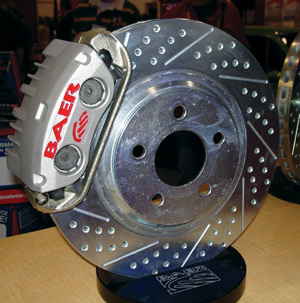 A well-designed performance rotor may also have directional cooling fins between the rotor faces to help pump more air through the rotor. This helps the rotor dissipate heat so the pads don’t get too hot and start to fade when the brakes are working hard.
A well-designed performance rotor may also have directional cooling fins between the rotor faces to help pump more air through the rotor. This helps the rotor dissipate heat so the pads don’t get too hot and start to fade when the brakes are working hard.
One thing to watch out for is replacement rotors that have thinner faces to save weight. Less weight is not necessarily a good thing when it comes to brake rotors because the rotors need a lot of thermal mass to absorb and dissipate heat. If the rotors are too thin, they may overheat and cause the brakes to fade.
Admittedly, many racing rotors are thinner and lighter than what you would see on a street-driven vehicle. But racing rotors may also be made of exotic high-temperature materials such as titanium, carbon fiber or even aluminum/ceramic. Racing rotors can be extremely expensive, up to $1,000 or more per wheel for rotors and pads, and most are not designed for or suitable for street use. Many racing rotors and pads don’t generate much brake force until they get really hot, so for everyday driving they wouldn’t even work as well as stock brakes.
The best advice is to follow the rotor manufacturer’s recommendations for use. The best choice is usually a slotted and/or drilled or dimpled street performance rotor that replaces the stock rotor (same size and thickness).
For highly modified cars, larger diameter rotors can provide more braking torque because of the “lever” effect. The larger the diameter of the rotor and the further out the pads are from the center of the rotor, the greater the braking leverage they can exert when the brakes are applied.
The limiting factor here is the inside diameter of the wheel. With stock diameter wheels, there’s usually no room inside the wheel to accommodate a larger rotor because the caliper would hit the wheel. But if a vehicle that originally had 14-inch or 15-inch wheels is fitted with 17-inch to 19-inch or larger aftermarket wheels, there’s usually a lot more room inside the wheels for larger brakes. A stock 10-inch rotor could probably be replaced with a larger 11-inch or even 12-inch rotor.
Another advantage of going to larger rotors is that larger rotors can handle larger pads. The greater the surface area of the pads, the more friction they can generate to stop the vehicle.
Larger rotors also help fill out the void behind large diameter, open-spoke style aftermarket wheels. Some customers may not need the extra stopping power of larger rotors, but are more concerned about appearance and want larger rotors for how they look more so than how they perform.
CALIPER UPGRADES
Replacing a set of calipers with remanufactured or new calipers certainly ups the total price of any brake job. Caliper replacement is usually necessary in high-mileage vehicles because of fluid leaks or because the calipers are sticking. But if a customer is serious about improving braking performance, replacing stock single-piston floating calipers with aftermarket multi-piston fixed calipers is the only way to go.
Most import and domestic vehicles come factory equipped with single-piston calipers. Why? Because they are adequate for normal braking and they are cheaper to manufacture than multi-piston calipers. Popular import makes favored by sport compact enthusiasts that come factory-equipped with single-piston calipers include Honda Accord, Civic and Integra, Mitsubishi Eclipse, Mazda Miata, Toyota Celica, and Volkswagen Golf, GTI and Jetta models. Dual-piston calipers are usually found only on the higher-end performance models such as Acura NSX, Mitsubishi 3000GT and 300ZX, and similar cars.
Aftermarket performance brake kits typically include rotors with the same or larger diameter, multi-piston fixed calipers that replace the stock calipers, new performance pads (typically some type of semi-metallic or ceramic/metallic formula), new braided stainless steel front brake hoses and new caliper mounts (if required). Installation requires removing the original rotors, calipers and caliper mounts (if necessary depending on the size of the replacement rotors and the type of caliper).
Some of these kits can be rather pricey, depending on the brand name and whether the kit is designed for the street or for serious racing. A customer can spend several hundred to thousands of dollars for such a kit. We did some price shopping online and found brake kits that ranged in price from $600 to $5,400 depending on the application.
Most of the aftermarket performance brake kits use fixed calipers rather than floating calipers. This is done so the calipers can squeeze the pads evenly from both sides. But this requires changing the caliper mounts and carefully aligning the calipers to the rotors when they are installed so the pads wear evenly. If a fixed caliper is not perfectly parallel to its rotor, the front and rear edges of the pads will not wear evenly.
There are several reasons why most aftermarket performance brake kits use multi-piston calipers instead of single-piston calipers. One is to multiply brake force. The amount of clamping force the caliper applies to squeeze the pads against the rotor depends on the surface area of the caliper piston and the amount of force generated by the master cylinder. If hydraulic pressure from the master cylinder remains the same as before, then increasing the surface area of the piston by using more than one piston multiplies braking force.
The amount of clamping force generated by a caliper can be calculated as follows: First, calculate the surface area of the caliper piston. You can do this by multiplying the diameter of the caliper piston times itself, and then multiply by 0.785 to get the total surface area. Or, use the formula 2 x 3.14 (pi) x half the diameter of the piston (the radius).
Once you have the piston area, multiply that by the line pressure generated by master cylinder needed to lock up the brakes (typically 800 to 1,400 psi, depending on the weight of the vehicle, the brake system and tire traction).
Let’s say the stock brake system has single-piston calipers with 2-inch pistons, and the line pressure from the master cylinder is 800 psi. In this case, each caliper will generate 2,198 lbs. of clamping force at the rotors.
If you replace the stock single-piston calipers with dual-piston calipers, the pistons are smaller (1-1/2 inches), but there are now two pistons instead of one. So the clamping force is now the surface area of each piston times two, times the line pressure. Do the math and you’ll see that a dual-piston caliper with smaller pistons actually generates more clamping pressure at the rotor than a single-piston caliper with a much larger piston: 2,471 lbs. versus 2,198 lbs.
If you upgrade the brakes even more and install a set of four-piston calipers, the clamping force doubles again (four pistons now vs. two). The four-piston caliper with 1-1/2 inch pistons now has a total piston surface area of 7.06 square inches and generates a hefty 4,942 lbs. of clamping force with the same line pressure. That’s why race cars and true performance cars have multi-piston calipers.
Another reason for using multi-piston calipers is to reduce pad flex for better clamping effectiveness and braking friction. If a caliper has a single, large piston and a relatively short pad, pad flex is usually not an issue. But if a caliper has longer pads (to increase the friction surface area), applying pressure only in the middle of the pad with a single piston may cause the ends of the pads to bow up slightly, with the most force being applied in the middle. So to ensure the full length of the pad contacts the rotor, two or more pistons are used to more evenly distribute the clamping force along the entire length of the pad.
To even out clamping force, some multi-piston performance calipers use different-sized pistons, typically smaller diameter pistons on the leading edge of the caliper and larger pistons behind it.
Most aftermarket performance calipers are aluminum rather than cast iron, and come powder-coated in a variety of bright colors. Some are also available with a clear anodized coating or are bright plated to resist corrosion and enhance their appearance. Installing a set of brightly colored calipers will certainly dress-up the appearance of any vehicle, and enhance the look of the brakes behind open-spoke alloy wheels.
UPGRADING FRICTION MATERIALS
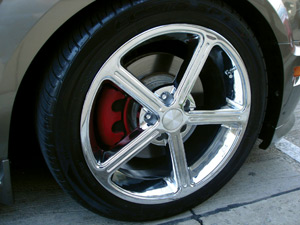 For street-driven performance cars, premium-grade pads are a must. Standard-grade pads are fine for everyday driving, and usually deliver OE-equivalent stopping performance, face resistance, pedal feel and wear characteristics. But for heavy-footed drivers or those who tend to eat brake pads, standard replacement pads may not be the best choice.
For street-driven performance cars, premium-grade pads are a must. Standard-grade pads are fine for everyday driving, and usually deliver OE-equivalent stopping performance, face resistance, pedal feel and wear characteristics. But for heavy-footed drivers or those who tend to eat brake pads, standard replacement pads may not be the best choice.
Premium pads are typically made with better materials, and feature things like slots and chamfers to dampen vibrations and noise. The backing plates may be stainless steel or plated to resist corrosion that can cause sticking and lining separation. The ingredients in the friction material are top of the line, and provide the best combination of wear, fade resistance, pedal feel and noise control. Consequently, they cost more — sometimes a lot more, up to two or three times as much as standard pads. But for customers who want the best, upgrading to premium pads is often well worth the extra cost.
Notice we’re recommending “premium” pads, not racing pads. There is a difference. Racing pads are formulated for extreme temperatures and driving conditions. This usually means racing pads don’t perform well at normal braking temperatures on a street-driven vehicle. As stated earlier, racing pads don’t generate much friction until they get hot, which means increased pedal effort and increased stopping distance until they get hot. Noise may also be an issue with hard, high-metallic content racing pads, as well as rotor wear.
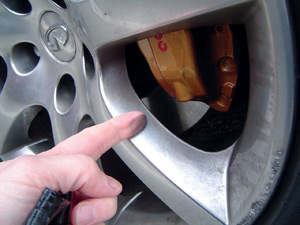 Another upgrade to consider is to replace OE-style pads with ceramic pads. Ceramic pads are a good upgrade for many passenger car applications. Ceramic pads are typically quieter than semi-metallic pads, and generate much less dust than non-asbestos organic pads like those on many BMW, Mercedes and other European makes. Some aftermarket ceramic pads are specially formulated to duplicate the performance and feel of OEM “Euro” linings without the dust issues.
Another upgrade to consider is to replace OE-style pads with ceramic pads. Ceramic pads are a good upgrade for many passenger car applications. Ceramic pads are typically quieter than semi-metallic pads, and generate much less dust than non-asbestos organic pads like those on many BMW, Mercedes and other European makes. Some aftermarket ceramic pads are specially formulated to duplicate the performance and feel of OEM “Euro” linings without the dust issues.
For serious performance, though, some type of premium-grade semi-metallic pads is usually best.





